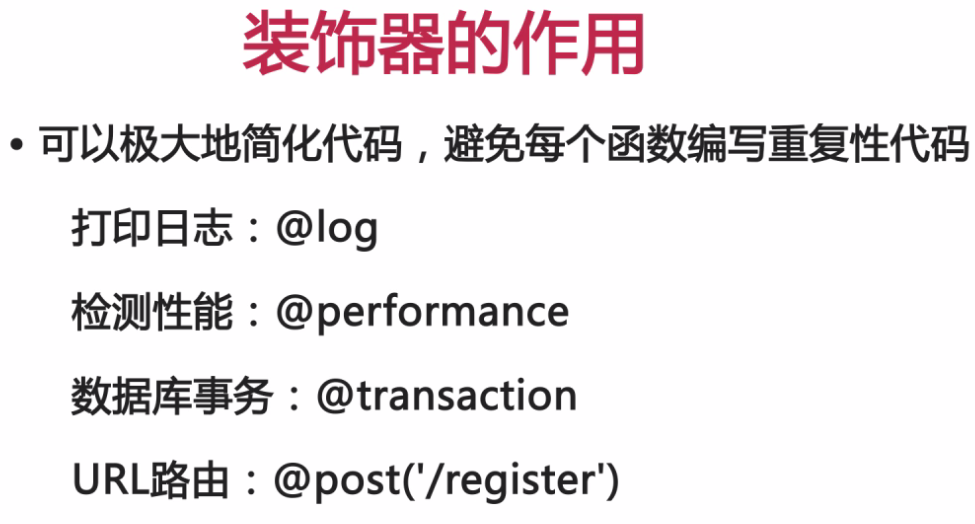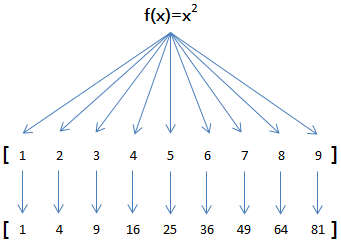python中的高阶函数
高阶函数就是 变量名指向函数,下面代码中的变量abs其实是一个函数,返回数字的绝对值,如abs(-10) 返回 10
def add(x,y,f): return f(x) +f(y) add(-5,9,abs) #14
python把函数作为参数
利用add(x,y,f)函数计算:

import math def add(x, y, f): return f(x) + f(y) print add(25, 9, math.sqrt) #5,3
python中map()函数
map()是 Python 内置的高阶函数,它接收一个函数 f 和一个 list,并通过把函数 f 依次作用在 list 的每个元素上,得到一个新的 list 并返回。
例如,对于list [1, 2, 3, 4, 5, 6, 7, 8, 9]
如果希望把list的每个元素都作平方,就可以用map()函数:
因此,我们只需要传入函数f(x)=x*x,就可以利用map()函数完成这个计算:
def f(x):
return x*x
print map(f, [1, 2, 3, 4, 5, 6, 7, 8, 9])
输出结果:
[1, 4, 9, 10, 25, 36, 49, 64, 81]
注意:map()函数不改变原有的 list,而是返回一个新的 list。
例如:假设用户输入的英文名字不规范,没有按照首字母大写,后续字母小写的规则,请利用map()函数,把一个list(包含若干不规范的英文名字)变成一个包含规范英文名字的list:
#小写转大写 def format_name(s): return s.title() print map(format_name, ['adam', 'LISA', 'barT']) #['Adam', 'Lisa', 'Bart']
python中reduce()函数
from functools import reduce # Python3.X中需要引入包
reduce()函数也是Python内置的一个高阶函数。reduce()函数接收的参数和 map()类似,一个函数 f,一个list,但行为和 map()不同,reduce()传入的函数 f 必须接收两个参数,reduce()对list的每个元素反复调用函数f,并返回最终结果值。
例如,编写一个f函数,接收x和y,返回x和y的和:
def f(x, y): return x + y
调用 reduce(f, [1, 3, 5, 7, 9])时,reduce函数将做如下计算:
先计算头两个元素:f(1, 3),结果为4; 再把结果和第3个元素计算:f(4, 5),结果为9; 再把结果和第4个元素计算:f(9, 7),结果为16; 再把结果和第5个元素计算:f(16, 9),结果为25; 由于没有更多的元素了,计算结束,返回结果25。
上述计算实际上是对 list 的所有元素求和。虽然Python内置了求和函数sum(),但是,利用reduce()求和也很简单。
reduce()还可以接收第3个可选参数,作为计算的初始值。如果把初始值设为100,计算:
reduce(f, [1, 3, 5, 7, 9], 100)
结果将变为125,因为第一轮计算是:
计算初始值和第一个元素:f(100, 1),结果为101。
例如:
Python内置了求和函数sum(),但没有求积的函数,请利用recude()来求积:
输入:[2, 4, 5, 7, 12]
输出:2*4*5*7*12的结果
def prod(x, y): return x*y print reduce(prod, [2, 4, 5, 7, 12])
python中filter()函数
filter()函数是 Python 内置的另一个有用的高阶函数,filter()函数接收一个函数 f 和一个list,这个函数 f 的作用是对每个元素进行判断,返回 True或 False,filter()根据判断结果自动过滤掉不符合条件的元素,返回由符合条件元素组成的新list。
例如,要从一个list [1, 4, 6, 7, 9, 12, 17]中删除偶数,保留奇数,首先,要编写一个判断奇数的函数:
def is_odd(x): return x % 2 == 1
然后,利用filter()过滤掉偶数:
filter(is_odd, [1, 4, 6, 7, 9, 12, 17])
py3 中还要加list,.....print(list( filter(is_sqr, range(1, 101)))
结果:[1, 7, 9, 17]
利用filter(),可以完成很多有用的功能,例如,删除 None 或者空字符串:
def is_not_empty(s): return s and len(s.strip()) > 0 filter(is_not_empty, ['test', None, '', 'str', ' ', 'END']) #['test', 'str', 'END'] #Python 3.X 中 print(list(filter(is_not_empty, ['test', None, '', 'str', ' ', 'END'])))
注意: s.strip(rm) 删除 s 字符串中开头、结尾处的 rm 序列的字符。
当rm为空时,默认删除空白符(包括' ', ' ', ' ', ' '),如下:
a = ' 123' a.strip() #结果: '123' a=' 123 ' a.strip() #结果:'123'
请利用filter()过滤出1~100中平方根是整数的数,即结果应该是:
[1, 4, 9, 16, 25, 36, 49, 64, 81, 100]
import math def is_sqr(x): r = int(math.sqrt(x)) return r*r==x print filter(is_sqr, range(1, 101))
#[1, 4, 9, 16, 25, 36, 49, 64, 81, 100]
#python 3.X print(list(filter(is_sqr, range(1, 101))))
#[1, 4, 9, 16, 25, 36, 49, 64, 81, 100]
python中自定义排序函数
Python内置的 sorted()函数可对list进行排序:
>>>sorted([36, 5, 12, 9, 21]) #[5, 9, 12, 21, 36]
但 sorted()也是一个高阶函数,它可以接收一个比较函数来实现自定义排序,比较函数的定义是,传入两个待比较的元素 x, y,如果 x 应该排在 y 的前面,返回 -1,如果 x 应该排在 y 的后面,返回 1。如果 x 和 y 相等,返回 0。
因此,如果我们要实现倒序排序,只需要编写一个reversed_cmp函数:
def reversed_cmp(x, y): if x > y: return -1 if x < y: return 1 return 0
这样,调用 sorted() 并传入 reversed_cmp 就可以实现倒序排序:
>>> sorted([36, 5, 12, 9, 21], reversed_cmp) #[36, 21, 12, 9, 5]
sorted()也可以对字符串进行排序,字符串默认按照ASCII大小来比较:
>>> sorted(['bob', 'about', 'Zoo', 'Credit']) ['Credit', 'Zoo', 'about', 'bob']
'Zoo'排在'about'之前是因为'Z'的ASCII码比'a'小。
例如:
对字符串排序时,有时候忽略大小写排序更符合习惯。请利用sorted()高阶函数,实现忽略大小写排序的算法。
输入:['bob', 'about', 'Zoo', 'Credit']
输出:['about', 'bob', 'Credit', 'Zoo']
def cmp_ignore_case(s1, s2): u1 = s1.upper() u2 = s2.upper() if u1 > u2: return 1 if u1 < u2: return -1 return 0 print sorted(['bob', 'about', 'Zoo', 'Credit'], cmp_ignore_case)
#python 3.X 中自定义排序函数 sorted() a = ['bob', 'about', 'Zoo', 'Credit'] print(sorted(a, key=str.lower)) l = [36, 5, 12, 9, 21] print(sorted(l, key=lambda x:(x<0,abs(x))))
python中返回函数
Python的函数不但可以返回int、str、list、dict等数据类型,还可以返回函数!
例如,定义一个函数 f(),我们让它返回一个函数 g,可以这样写:
def f(): print 'call f()...' # 定义函数g: def g(): print 'call g()...' # 返回函数g: return g
仔细观察上面的函数定义,我们在函数 f 内部又定义了一个函数 g。由于函数 g 也是一个对象,函数名 g 就是指向函数 g 的变量,所以,最外层函数 f 可以返回变量 g,也就是函数 g 本身。
调用函数 f,我们会得到 f 返回的一个函数:
>>> x = f() # 调用f() call f()... >>> x # 变量x是f()返回的函数: <function g at 0x1037bf320> >>> x() # x指向函数,因此可以调用 call g()... # 调用x()就是执行g()函数定义的代码
请注意区分返回函数和返回值:
def myabs(): return abs # 返回函数 def myabs2(x): return abs(x) # 返回函数调用的结果,返回值是一个数值
返回函数可以把一些计算延迟执行。例如,如果定义一个普通的求和函数:
def calc_sum(lst): return sum(lst)
调用calc_sum()函数时,将立刻计算并得到结果:
>>> calc_sum([1, 2, 3, 4])
10
但是,如果返回一个函数,就可以“延迟计算”:
def calc_sum(lst): def lazy_sum(): return sum(lst) return lazy_sum
# 调用calc_sum()并没有计算出结果,而是返回函数:
>>> f = calc_sum([1, 2, 3, 4]) >>> f <function lazy_sum at 0x1037bfaa0>
# 对返回的函数进行调用时,才计算出结果:
>>> f()
10
由于可以返回函数,我们在后续代码里就可以决定到底要不要调用该函数。
例如:
请编写一个函数calc_prod(lst),它接收一个list,返回一个函数,返回函数可以计算参数的乘积。
def calc_prod(lst): def lazy_prod(): def f(x,y): return x*y return reduce(f, lst, 1) return lazy_prod f = calc_prod([1, 2, 3, 4]) print f()
python中闭包
在函数内部定义的函数和外部定义的函数是一样的,只是他们无法被外部访问:
def g(): print 'g()...' def f(): print 'f()...' return g
将 g 的定义移入函数 f 内部,防止其他代码调用 g:
def f(): print 'f()...' def g(): print 'g()...' return g
但是,考察上一小节定义的 calc_sum 函数:
def calc_sum(lst): def lazy_sum(): return sum(lst) return lazy_sum
注意: 发现没法把 lazy_sum 移到 calc_sum 的外部,因为它引用了 calc_sum 的参数 lst。
像这种内层函数引用了外层函数的变量(参数也算变量),然后返回内层函数的情况,称为闭包(Closure)。
闭包的特点是返回的函数还引用了外层函数的局部变量,所以,要正确使用闭包,就要确保引用的局部变量在函数返回后不能变。
例如:
返回闭包不能引用循环变量,请改写count()函数,让它正确返回能计算1x1、2x2、3x3的函数。
def count(): fs = [] for i in range(1, 4): def f(j): def g(): return j*j return g r = f(i) fs.append(r) return fs f1, f2, f3 = count() print f1(), f2(), f3()
python中匿名函数 lambda函数
高阶函数可以接收函数做参数,有些时候,我们不需要显式地定义函数,直接传入匿名函数更方便。
在Python中,对匿名函数提供了有限支持。还是以map()函数为例,计算 f(x)=x2 时,除了定义一个f(x)的函数外,还可以直接传入匿名函数:
#Function 正常使用的表达方法 def func(n): return n + 1 print(func(2)) #Lambda 表达方法 f = lambda x:x+1 print(f) print(f(2)) >>> map(lambda x: x * x, [1, 2, 3, 4, 5, 6, 7, 8, 9]) [1, 4, 9, 16, 25, 36, 49, 64, 81] #Python 3.X中是: print(list(map(lambda x: x * x, [1,2,3,4,5,6,7,8,9]))) #[1, 4, 9, 16, 25, 36, 49, 64, 81]
当然Lambda表达式也有以下的使用情况:
#多参数情况 print("多参数情况") multi = lambda x,y,z: x+y+z print(multi(1,2,3)) #和非匿名函数一块工作 print("和非匿名函数一块工作") def namedFunc(n): return lambda x:n+x print(namedFunc(2)) #会打印出function,相当于 lambda x: 2+x print(namedFunc(2)(3)) #会打印出5 f = namedFunc(2) print(f(3)) #等同于namedFunc(2)(3)
通过对比可以看出,匿名函数 lambda x: x * x 实际上就是:
def f(x): return x * x
关键字lambda 表示匿名函数,冒号前面的 x 表示函数参数。
匿名函数有个限制,就是只能有一个表达式,不写return,返回值就是该表达式的结果。
例如:
print filter(lambda s: s and len(s.strip())>0, ['test', None, '', 'str', ' ', 'END']) #Python3.x 中是这样的: print(list(filter(lambda s: s and len(s.strip())>0, ['test', None, '', 'str', ' ', 'END'])))
对于lambda表达式在Python程序中的一些小建议:
1. 对于简单的逻辑处理,可以放心使用Lambda表达式,这样比较简洁
2. 对于复杂的逻辑处理,尽量避免使用Lambda表达式,易读性差,而且容易出错(大牛除外)
python 中 decortor 装饰器

python中编写无参数decorator
Python的 decorator 本质上就是一个高阶函数,它接收一个函数作为参数,然后,返回一个新函数。
使用 decorator 用Python提供的 @ 语法,这样可以避免手动编写f = decorate(f) 这样的代码。
考察一个@log的定义:
def log(f): def fn(x): print 'call ' + f.__name__ + '()...' return f(x) return fn
对于阶乘函数,@log工作得很好:
@log def factorial(n): return reduce(lambda x,y: x*y, range(1, n+1)) print factorial(10)
结果:
call factorial()...
3628800
但是,对于参数不是一个的函数,调用将报错:
@log def add(x, y): return x + y print add(1, 2) #结果: Traceback (most recent call last): File "test.py", line 15, in <module> print add(1,2) TypeError: fn() takes exactly 1 argument (2 given)
因为 add() 函数需要传入两个参数,但是 @log 写死了只含一个参数的返回函数。
要让 @log 自适应任何参数定义的函数,可以利用Python的 *args 和 **kw,保证任意个数的参数总是能正常调用:
def log(f): def fn(*args, **kw): print 'call ' + f.__name__ + '()...' return f(*args, **kw) return fn
现在,对于任意函数,@log 都能正常工作。
例子:
请编写一个@performance,它可以打印出函数调用的时间。
import time def performance(f): def fn(*args, **kw): t1 = time.time() r = f(*args, **kw) t2 = time.time() print 'call %s() in %fs' % (f.__name__, (t2 - t1)) return r return fn @performance def factorial(n): return reduce(lambda x,y: x*y, range(1, n+1)) print factorial(10)
